Page 6 of 18
AW Insect Book: Sawflies, Wasps, Bees & Ants (Hymenoptera)
Posted: Wed Dec 24, 2014 10:38 am
by BluTuna
Giant Black Spider-hunting Wasp Java atropos
Superfamily Vespoidea. Family Pompilidae. Subfamily Pepsinae
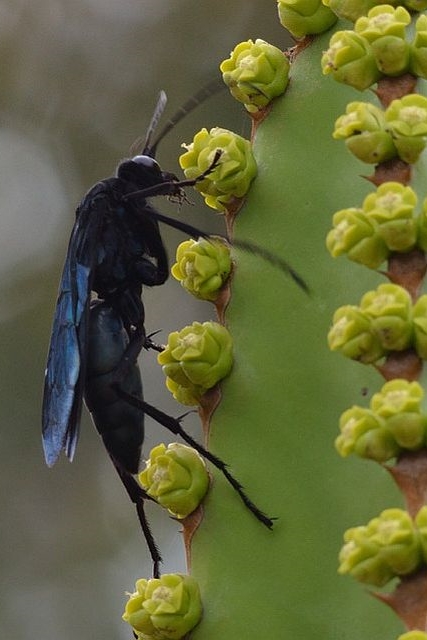
© BluTuna
Kruger National Park, Paul Kruger Gate
Distribution
Ethiopia, South Africa, Uganda, Zimbabwe.
Habitat
Bushveld and savannah.
Biology
Females hunt large spiders such as Rain spiders (
Palystes) which they paralyse and drag to a pre-excavated burrow or crack or crevice. An egg is laid on the spider which provides the larva with food when it hatches.
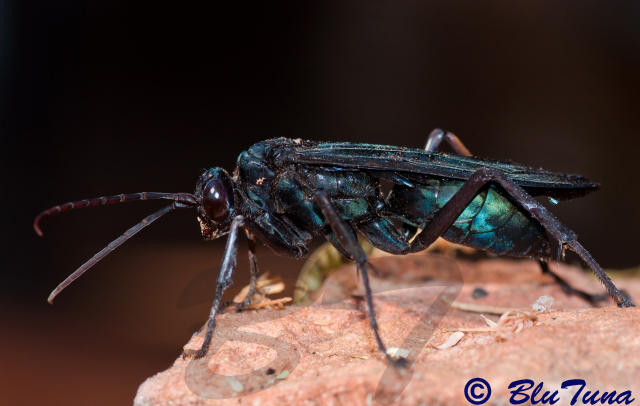
© BluTuna
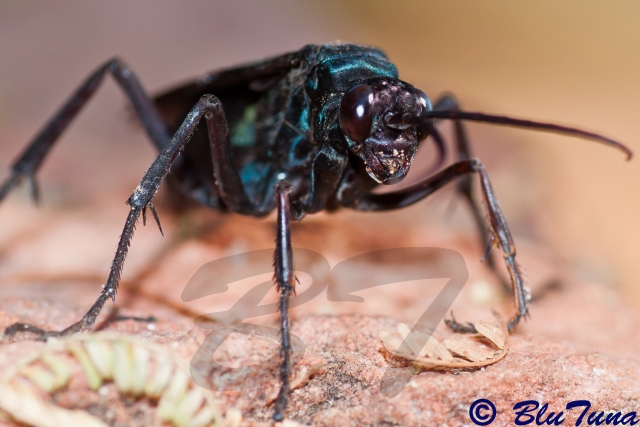
© BluTuna
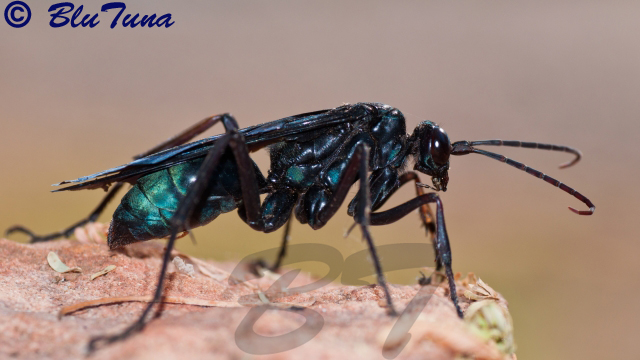
© BluTuna
Kruger National Park, Shingwedzi
Links:
http://www.waspweb.org/Vespoidea/Pompil ... tropus.htm
AW Insect Book: Sawflies, Wasps, Bees & Ants (Hymenoptera)
Posted: Wed Dec 24, 2014 10:49 am
by BluTuna
Spider-hunting Wasp Hemipepsis tamisieri
Superfamily: Vespoidea. Family: Pompilidae. Subfamily: Pepsinae
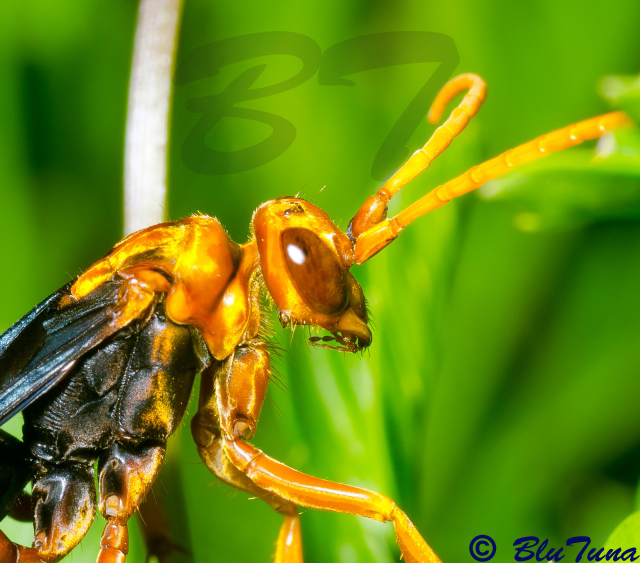
© BluTuna
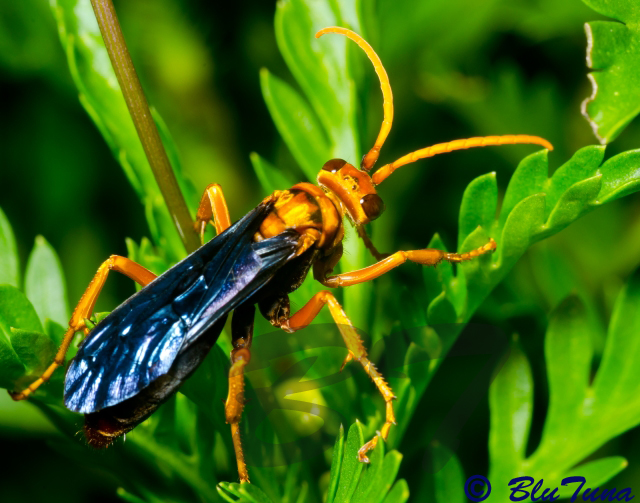
© BluTuna
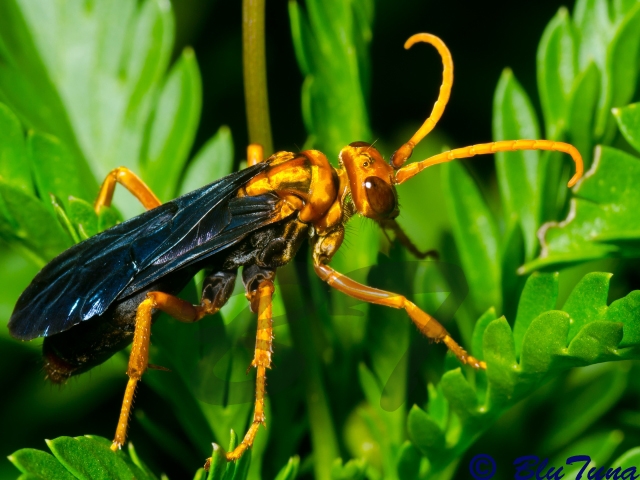
© BluTuna
Garden in Johannesburg
Distribution
Angola, Ethiopia, Gold Coast, Malawi, Nigeria, Sierra Leone, South Africa, Uganda, Zambia, Zimbabwe.
Habitat
On the ground, usually searchy among dead leaves or low vegetation.
Biology
Adults feed on nectar and pollen.
Females specialise on hunting Baboon spiders (
Theraphosidae) and Rain spiders (
Palystes) to provision their nest with as a paralysed food resource for development of their larvae.
Links:
WaspWeb;
Picker, M., Griffiths, C & Weaving, A.: Field Guide to Insects of South Africa
AW Insect Book: Sawflies, Wasps, Bees & Ants (Hymenoptera)
Posted: Wed Dec 24, 2014 10:49 am
by BluTuna
Spider-hunting Wasp Hemipepsis sp.
Superfamily: Vespoidea. Family: Pompilidae. Subfamily: Pepsinae
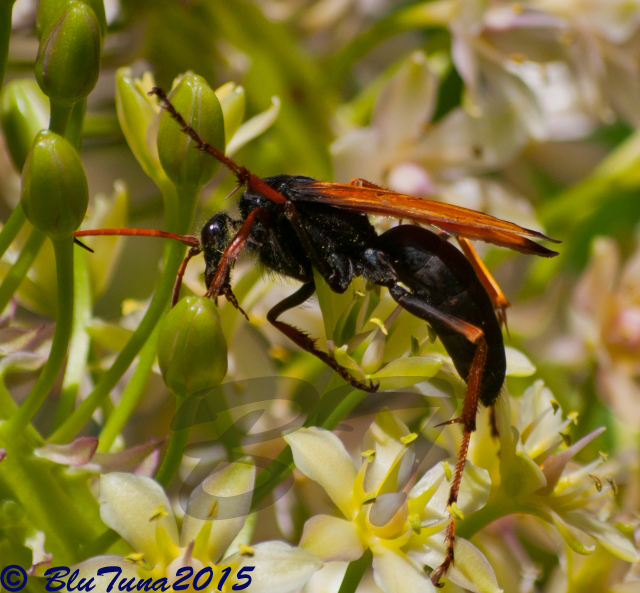
© BluTuna
Walter Sisulu National Botanical Garden, Johannesburg
Biology
Females hunt mainly Baboon spiders (Theraphosidae) and Rain spiders (
Palystes), which they paralyse and drag to a pre-excavated burrow, where they lay an egg on the spider. On hatching the larva feeds on the preserved prey item. Species of
Hemipepsis are important specialist pollinators of a diverse assemblage of African plants from
Satyrium and
Disa orchids (Orchidaceae) to Milkweeds (Apocynaceae) and
Eucomis species (Asparagaceae subfamily Scilloideae), as well as plants with generalist pollination systems (Apiaceae, Vitaceae).
Links:
WaspWeb
AW Insect Book: Sawflies, Wasps, Bees & Ants (Hymenoptera)
Posted: Wed Dec 24, 2014 10:49 am
by Toko
Spider-hunting Wasp Hemipepsis sp.
Superfamily: Vespoidea. Family: Pompilidae. Subfamily: Pepsinae
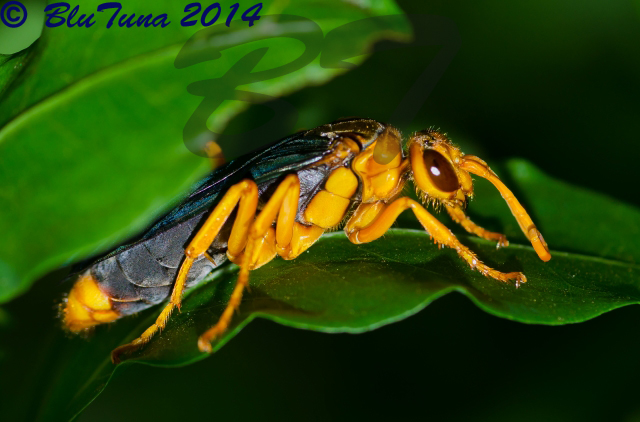
© BluTuna
Crocodile Bridge Camp, Kruger National Park
Links:
WaspWeb
Hymenoptera: Vespoidea, Pompilidae, Pompilinae
Posted: Wed Dec 24, 2014 10:56 am
by Toko
Subfamily Pompilinae
The Pompilinae are worldwide in distribution.
The legs are long; they are principally adapted for agile, fast running, and secondarily, for excavation of burrows. The abdomen consists of six visible segments in the female and seven in the male; only the male has cerci (= pygostyles). The abdominal articulation is between the propodeum and the second true abdominal segment. S2 with a well defined, transverse groove (absent in some malea); labrum at least partially hidden beneath clypeus; hypopygium of female without a ventral keel or sharp fold; dorsal surface of posterior tibia often with a series of teeth or serration.
Biology
Females hunt a variety of spiders with many targeting Orb-web spiders (Araneidae), capturing the spider in its web, to provision their nest with. Others hunt spiders in the genus
Palystes (Palystinae; Heteropodidae). Adult wasps feed on nectar for their energy requirements. The paralysed spiders are carried or dragged to a pre-constructed nest, where they lay an egg on the spider. On hatching the larva feeds on the preserved prey item.
Links:
WaspWeb
AW Insect Book: Sawflies, Wasps, Bees & Ants (Hymenoptera)
Posted: Wed Dec 24, 2014 11:29 am
by Flutterby
Spider-hunting Wasp Tachypompilus ignitus
Superfamily: Vespoidea. Family: Pompilidae. Subfamily: Pompilinae
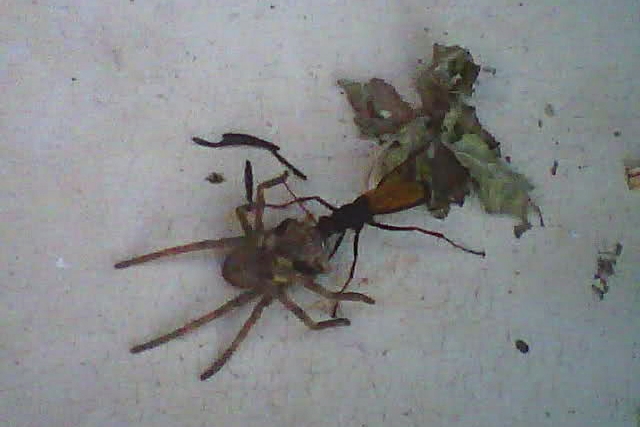
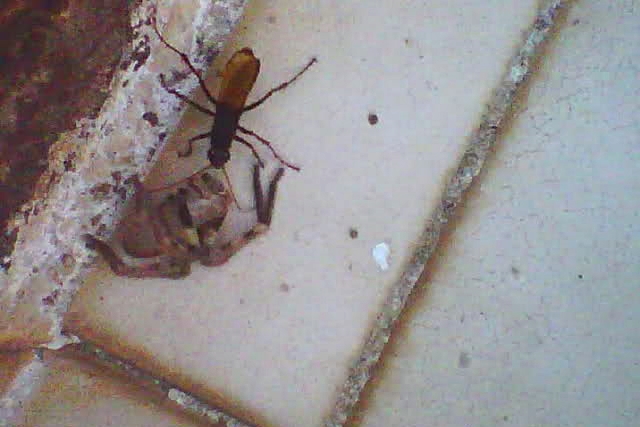
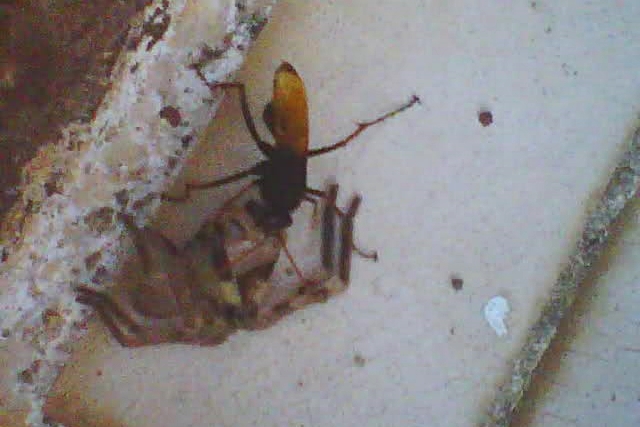 Description
Description
About 45 mm in length. They are largely black with orange antennae, orange dital parts of the legs, and largely orange wings, which are dark at the base and tip.
Distribution
Found all over South Africa and in Zimbabwe.
Biology
Hunts spiders in the genus
Palystes.
Links:
http://www.waspweb.org/Vespoidea/Pompil ... gnitus.htm
Hymenoptera: Vespoidea, Scoliidae (Mammoth Wasps)
Posted: Wed Dec 24, 2014 11:49 am
by Toko
Family Scoliidae (Mammoth Wasps)
The family Scoliidae belongs to the superfamily Vespoidea. They are solitary insects and fly around low-growing vegetation, manure and compost heaps. Both male and female are winged. Their wing tips are distinctively corrugated longitudinally. The wings are iridescent, dark brown, blue or clear, with or without brown tips. They are medium to large (body length 10-50 mm), robust, bristly. Colour variable, they tend to be black, often marked with yellow or orange, sometimes with reddish hairs on head and thorax as in
Campsomeriella caelebs or on tip of abdomen.
Scolia wahlbergi has a bright yellow head, antennae and pronotum. Other species are banded with yellow. Males are more slender, sometimes differently coloured from females, with 3 sharp spines projecting from rear of abdomen. Males have often longer antennae. Females have a true stinger, retracted inside the abdomen when not being deployed.
Distribution
Worldwide.
Diversity
The family Scoliidae contains approximately about 560 valid species, 220 subspecies distributed among 43 valid genera, 28 subgenera and 2 subfamilies (Campsomerinae and Scoliinae).
Biology
External parasitoids of beetle larvae (mostly Scarabaeidae) that live in soil or decaying vegetable matter. Larvae pupate in a tough cocoon in soil.
Links:
WaspWeb
Hymenoptera Vespoidea, Scoliidae, Campsomerinae
Posted: Wed Dec 24, 2014 1:55 pm
by Toko
Subfamily Campsomerinae (Campsomerine Wasps)
The subfamily Campsomerinae belongs to the family Scoliidae. The adults use nectar as a food source and are common on flowers. Campsomerinae are easily distinguished from Scoliinae by the presence of two submarginal cells and two recurrent veins (of which second recurrent vein always running from subdiscoidal to cubital vein) in forewing.
Distribution
Worldwide.
Diversity
The subfamily contains two tribes in South Africa: Campsomerini (genera:
Campsomeriella, Charimeris, Extrameris, Leomeris, Megameris, Micromeriella, Peltatimeris, Turbatimeris, Tureimeris) and Trielidini (genera:
Crioscolia, Guigliana, Trielis)
Biology
The females of the subfamily Campsomerinae are predators on white grubs (Scarabaeidae), using these larvae as food for their young. Unlike sphecids, eumenines, and pompilids these wasps do not appear to have any type of prey transportation and dig to the ground-dwelling beetle larvae, sting it to paralyze it, and then lay an egg. They may dig around the grub to form a small cell. Since they use this nesting strategy they are often seen flying low to the ground (searching) in a figure eight pattern (but the flight pattern gets more erratic when they "smell" something).
Links:
WaspWeb
AW Insect Book: Sawflies, Wasps, Bees & Ants (Hymenoptera)
Posted: Wed Dec 24, 2014 2:10 pm
by Toko
Campsomerine Mammoth Wasp Micromeriella atropos
Superfamily Vespoidea. Family Scoliidae. Subfamily Campsomerinae. Tribe Campsomerini
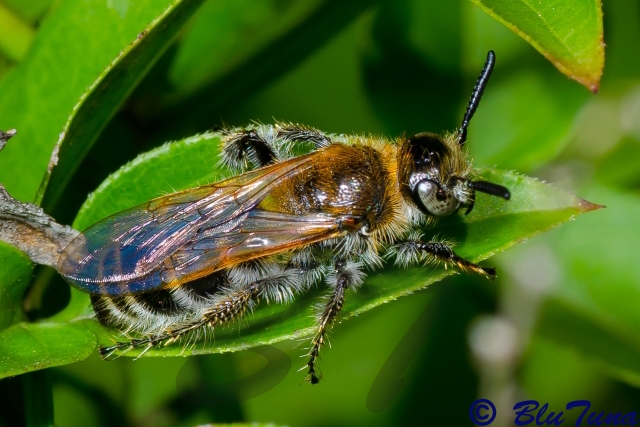
© BluTuna
Garden in Johannesburg
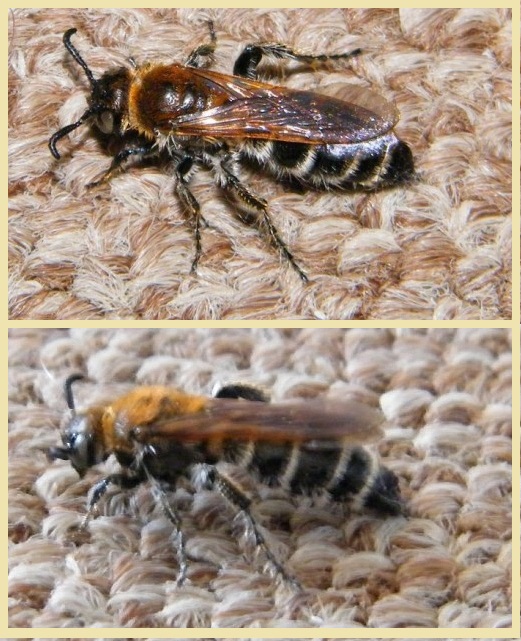
- Campsomerine mammoth wasp.JPG (145.66 KiB) Viewed 3026 times
Nelspruit © Richprins
Biology
Campsomerini wasps are external parasitoids of beetle larvae (mostly Scarabaeidae) that live in soil or decaying vegetable matter.
Links:
https://www.waspweb.org/Vespoidea/Scoli ... tropos.htm
AW Insect Book: Sawflies, Wasps, Bees & Ants (Hymenoptera)
Posted: Wed Dec 24, 2014 2:33 pm
by Toko
Campsomerine Mammoth Wasp possibly
Campsomeriella sp.
Family: Scoliidae. Subfamily: Campsomerinae. Tribe: Campsomerini
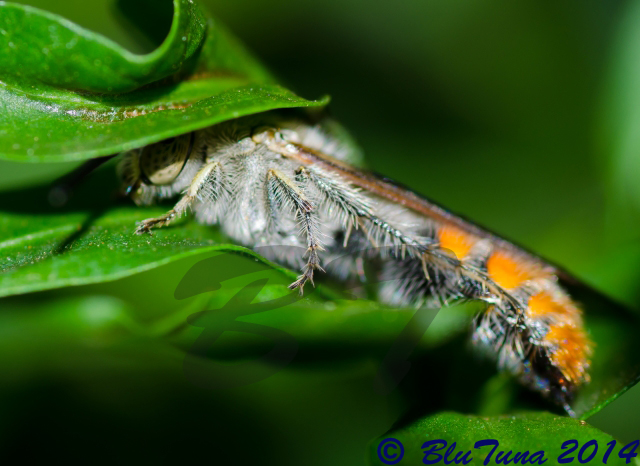
© BluTuna
Crocodile Bridge Camp, Kruger National Park
Links:
WaspWeb
 © BluTuna
© BluTuna © BluTuna
© BluTuna © BluTuna
© BluTuna © BluTuna
© BluTuna © BluTuna
© BluTuna © BluTuna
© BluTuna © BluTuna
© BluTuna © BluTuna
© BluTuna © BluTuna
© BluTuna © BluTuna
© BluTuna © BluTuna
© BluTuna © BluTuna
© BluTuna © BluTuna
© BluTuna


 © BluTuna
© BluTuna © BluTuna
© BluTuna